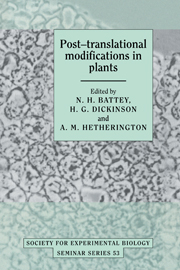Book contents
- Frontmatter
- Contents
- List of contributors
- List of abbreviations
- Preface
- Some roles of post-translational modifications in plants
- Signal transduction and protein phosphorylation in bacteria
- Roles of protein phosphorylation in animal cells
- The significance of post-translational modification of proteins by phosphorylation in the regulation of plant development and metabolism
- Post-translational modification of chloroplast proteins and the regulation of protein turnover
- Purification of a small phosphoprotein from chloroplasts and characterisation of its phosphoryl group
- Use of synthetic peptides to study G proteins and protein kinases within plant cells
- Activation of membrane-associated protein kinase by lipids, its substrates, and its function in signal transduction
- Distribution and function of Ca2+-dependent, calmodulin-independent protein kinases
- Phosphorylation of the plasma membrane proton pump
- The regulation of phosphoenolpyruvate carboxylase by reversible phosphorylation
- Protein phosphorylation and circadian rhythms
- Control of translation by phosphorylation of mRNP proteins in Fucus and Xenopus
- Regulation of plant metabolism by reversible protein (serine/threonine) phosphorylation
- Detection, biosynthesis and some functions of glycans N-linked to plant secreted proteins
- Biosynthesis, intracellular transport and processing of ricin
- Post-translational processing of concanavalin A
- The role of cell surface glycoproteins in differentiation and morphogenesis
- Ubiquitination of proteins during floral development and senescence
- Index
Post-translational processing of concanavalin A
Published online by Cambridge University Press: 06 July 2010
- Frontmatter
- Contents
- List of contributors
- List of abbreviations
- Preface
- Some roles of post-translational modifications in plants
- Signal transduction and protein phosphorylation in bacteria
- Roles of protein phosphorylation in animal cells
- The significance of post-translational modification of proteins by phosphorylation in the regulation of plant development and metabolism
- Post-translational modification of chloroplast proteins and the regulation of protein turnover
- Purification of a small phosphoprotein from chloroplasts and characterisation of its phosphoryl group
- Use of synthetic peptides to study G proteins and protein kinases within plant cells
- Activation of membrane-associated protein kinase by lipids, its substrates, and its function in signal transduction
- Distribution and function of Ca2+-dependent, calmodulin-independent protein kinases
- Phosphorylation of the plasma membrane proton pump
- The regulation of phosphoenolpyruvate carboxylase by reversible phosphorylation
- Protein phosphorylation and circadian rhythms
- Control of translation by phosphorylation of mRNP proteins in Fucus and Xenopus
- Regulation of plant metabolism by reversible protein (serine/threonine) phosphorylation
- Detection, biosynthesis and some functions of glycans N-linked to plant secreted proteins
- Biosynthesis, intracellular transport and processing of ricin
- Post-translational processing of concanavalin A
- The role of cell surface glycoproteins in differentiation and morphogenesis
- Ubiquitination of proteins during floral development and senescence
- Index
Summary
Concanavalin A (Con A) is a plant lectin, making up some 30% of the protein in jackbean seeds. At seed maturity, the protein is located in the protein bodies of the storage parenchyma cells within the cotyledons of the seed. The biosynthesis and processing of Con A have been studied in a number of laboratories; the resulting data indicate a complex and novel series of events.
Glycoconjugates in jackbean seeds are recognised by the endogenous lectin
At Leeds, our studies on concanavalin A (Con A) began more than ten years ago, when we were interested in determining the range of endogenous glycoconjugates in jackbeans that could interact with the lectin. Our aim was to gain insight into the nature of lectin–receptor interactions within the seed, and thereby to understand the potential function of the lectin through the types of glycoproteins and/or glycolipids available for complexing.
Using the technique of Con A overlays of jackbean polypeptides separated by SDS–PAGE, we found that only one polypeptide bound the lectin, the heavy subunit (66 kDa) of the enzyme α-mannosidase (Bowles, Andralojc & Marcus, 1982). However, the interaction between the lectin and the hydrolase could only be demonstrated if the enzyme was first denatured; in the native form of the enzyme, the N-glycan was inaccessible for binding to Con A (Bowles, Chaplin & Marcus, 1983). This suggested that in native tetrameric form, the N-glycan is sterically hindered from binding through positioning of the heavy and light subunits within the oligomer.
- Type
- Chapter
- Information
- Post-translational Modifications in Plants , pp. 257 - 266Publisher: Cambridge University PressPrint publication year: 1993
- 3
- Cited by



